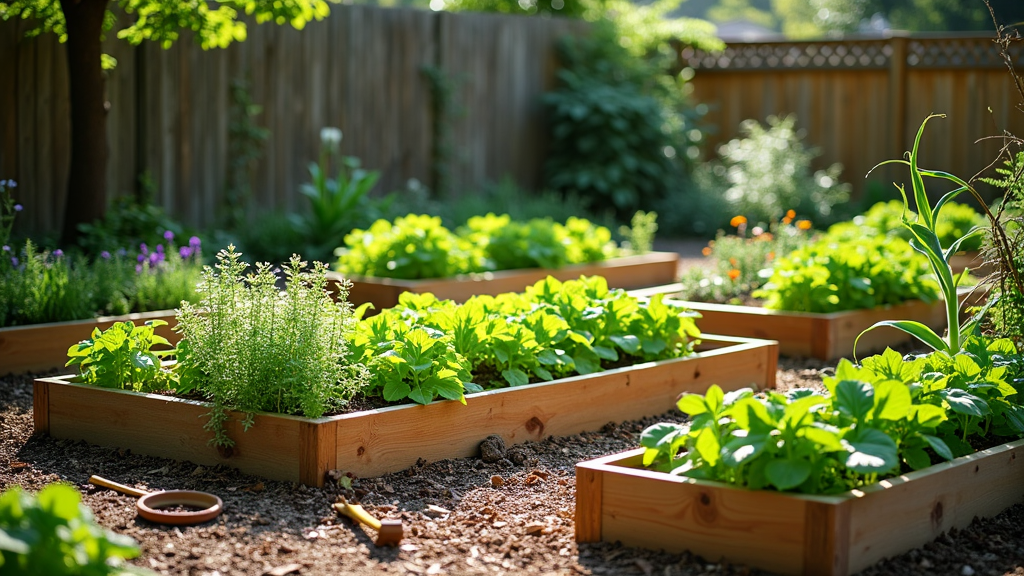 Raised wooden beds can totally change how I garden, whether I’m just starting or have years of experience. Planning and building my own raised beds helps keep weeds in check, improves soil quality, and makes it much easier on my back and knees. If I’m feeling overwhelmed by a messy patch of ground or tired of fighting with compacted soil, raised beds offer a practical and tidy solution.
Raised wooden beds can totally change how I garden, whether I’m just starting or have years of experience. Planning and building my own raised beds helps keep weeds in check, improves soil quality, and makes it much easier on my back and knees. If I’m feeling overwhelmed by a messy patch of ground or tired of fighting with compacted soil, raised beds offer a practical and tidy solution.
Getting started with raised wooden beds doesn’t mean a giant investment or complicated building skills. Many gardeners—including me—find that careful planning and some basic tools are all it takes. Once the beds are in place, preparing them with the right soil mix sets the stage for healthy, productive plants all season long.
This guide walks through every step I take to prepare my garden with raised wooden beds. By the end, I’ll know exactly how to go from an empty patch of lawn to flourishing beds ready for veggies, herbs, or flowers.
Figuring Out Where to Put Raised Beds
The right location for my raised beds can make a big difference. I always start by looking for a spot that gets at least 6 to 8 hours of sun each day. Most vegetables and flowers need that much sun to thrive. If tall structures or trees cast too much shade, I’d rather pick a new spot or trim some branches if possible.
I make sure the ground is pretty flat, or at least not so sloped that rainwater will wash my soil away. If the yard isn’t level, I spend a little extra time to even things out or work with the natural contours, putting the shorter end of the bed uphill to help with drainage.
Thinking About Water and Access
- Water access is super important, so I try to place the beds close to a tap or hose hookup. Dragging a heavy hose across the yard gets old fast.
- Paths between beds should be wide enough for me (and maybe a wheelbarrow) to move around easily; about 2 to 3 feet works well.
- If rabbits, deer, or other animals tend to visit, I plan for fencing or netting from the very beginning. Installing this later is a hassle.
Spending time planning the layout now saves me a lot of frustration later. I also make sure there is enough room for at least a small tool shed or spot for garden tools nearby, which makes my gardening routine smoother.
Picking Materials and Building the Beds
I’ve found that untreated cedar or redwood is a good choice for building raised beds. These woods resist rot naturally and don’t contain chemicals that could leach into the soil. Pine is less expensive but breaks down faster, so I usually use it if I’m on a tight budget and don’t mind rebuilding after a few years.
My go-to size for a raised bed is 4 feet wide and any length up to 8 feet. Beds should be no wider than 4 feet because anything wider means I can’t easily reach the center. Keeping beds about 8 to 12 inches tall is usually enough, but 18 to 24 inches works well for root crops or anyone wanting less bending over. I use deck screws or galvanized hardware to assemble the frames so they hold up to water and weather.
Keeping It Simple
- I cut my boards at the hardware store, so I don’t need fancy tools.
- If rot or ants are a big problem in my area, lining the bed’s bottom with fine mesh hardware cloth blocks burrowing pests without stopping drainage.
- If you want a next-level cool look, staining the outside of the wood with a natural, plant-safe sealant adds some style and extends the life of the bed.
Once the frames are ready, I set them on the prepared ground and make sure everything sits flat and level before filling. Adding a layer of landscape fabric beneath the beds also can make weeding less of a chore during the growing season.
Preparing the Foundation and Filling the Beds
Preparing the ground under my raised beds helps avoid trouble later. I do a quick pass to pull up weeds or grass where the beds will go. For tough weeds like Bermuda grass, I put down a layer of cardboard or several sheets of newspaper before setting the wooden frame in place. These biodegradable barriers help block new weeds while letting water through.
The Right Soil Mix
Good soil is what sets raised beds apart. I use a simple recipe that works for vegetables, herbs, and flowers:
- 1/3 topsoil, which provides structure and minerals.
- 1/3 compost, supplying nutrients for healthy growth.
- 1/3 aerating material (like peat moss, coconut coir, or aged leaf mold), to keep the soil loose and well-drained.
Sometimes I add a few cups of organic fertilizer or a little worm castings for an extra boost. Mixing ingredients thoroughly before filling the bed helps prevent pockets of dense or dry soil.
If building a really tall bed (over 18 inches), I save a little money by filling the bottom third with sticks, logs, or old leaves; this is sometimes called “hugelkultur.” These materials break down over time but won’t harm new plants and reduce how much pricey soil I need at first.
You can also blend in perlite or vermiculite for extra drainage if your climate has lots of rain. And if your topsoil isn’t very rich, don’t be afraid to blend in storebought garden soil for those first few fills.
Choosing Plants for Raised Beds
One of my favorite parts of having raised wooden beds is how much control I have over what to grow. I usually start with a mix of easy veggies like lettuce, spinach, carrots, radishes, or bush beans. Herbs such as basil, chives, and parsley do well too. Flowers like marigolds or nasturtiums make the beds look beautiful and help attract pollinators.
If you want to try something a little different, strawberries, dwarf peppers, or even cut flower mixes bring in more color and fun to your space. Many folks find that mixing crops not only looks next-level cool but also helps keep the bed productive throughout the season.
Planning the Layout Inside the Beds
- I give each plant the spacing it needs; most seed packets or plant tags give a good guideline. Crowding can reduce airflow and encourage mildew or bugs.
- Taller plants, like tomatoes or peas, go at the north end of the bed so they don’t cast shade on shorter plants.
- I mix in quick growers like radishes with slower veggies. This way, I can harvest the fast crops before the slow ones need the extra space.
With good planning, raised beds can produce several rounds of crops in a season, which keeps things interesting and maximizes the space. Rotating your crops each year also helps keep soil healthy and reduces pest buildup over time.
Maintenance Tips for Healthy Beds
Maintaining my raised beds doesn’t take much time if I keep up with a simple routine. I make a habit of checking soil moisture every couple of days with my finger—if it feels dry an inch or two down, it’s time to water. Raised beds do dry out faster than in-ground gardens, so regular watering is super important.
- I keep mulch, like straw or shredded leaves, on the surface. This holds in water and cuts the number of weeds by a lot.
- Adding fresh compost between growing seasons keeps my soil rich. Every spring and fall, I top up the beds with an inch or two.
- I look for signs of bugs or disease early, so I can deal with small problems before they get out of hand. Most garden pests are easier to spot in raised beds because I can see everything clearly.
Adding a drip irrigation line can also save time and water, especially during hot stretches. If you tend to travel, setting up a timer helps make sure your plants stay happy. With just a few minutes of attention each week, my raised beds stay productive and neat year after year.
Common Questions & Troubleshooting
How do I keep the wood from rotting?
Choosing rot-resistant wood like cedar or redwood helps a lot. If the budget only allows pine, I accept that I’ll need to replace it sooner. Keeping beds full of healthy, living soil and adding mulch or compost regularly can slow down the breakdown too. I avoid painting or treating the inside of the beds with chemicals that could get into the soil. For even more durability, you can use composite lumber, though it can cost more.
What if my soil level drops over time?
Soil always settles. Each season, I add more compost and topsoil to bring it up to the right level. This also refreshes nutrients for new plants. After several years, it’s normal for soil levels to drop quite a bit; just keep topping off and your plants will thank you with bigger harvests.
How can I keep animals from digging?
- I lay wire mesh or hardware cloth under the beds if burrowing pests are a problem.
- Simple hoops or a low fence keep out larger animals like rabbits, especially if I notice chewed leaves or missing sprouts.
Building beds with covers or hoops also makes it easier to add bird netting or row cover when needed. Sometimes, motion-activated sprinklers can help with persistent visitors. Scent deterrents, like crushed garlic or pet hair, may also persuade animals to move on.
Next Steps for a Thriving Raised Bed Garden
Raised wooden beds help me grow healthy, beautiful plants with less effort and frustration. Careful planning of layout, materials, and soil setup gives my garden the strong start it needs. Over time, I can see the difference in stronger plants, easier weeding, and harvests I’m proud of. Raised beds also let me switch up what I grow from season to season; from quick lettuce and radishes to tomatoes and squash.
If you’re eager to dig into gardening, raised beds can give you a head start and make the process more enjoyable. Don’t be afraid to experiment; every season brings new ideas to test out.
My Simple Raised Bed Action Plan:
- Pick a sunny, level spot in my yard.
- Choose or build wooden frames, and prep the area with weed barrier if needed.
- Mix up a balanced soil blend and fill my beds.
- Plant easy crops and mulch to hold in water.
- Keep up with regular watering and seasonal compost to keep soil healthy.
What’s the first thing you want to grow in your raised wooden bed this season? If you have tips or plant suggestions, ask away. Happy gardening!


